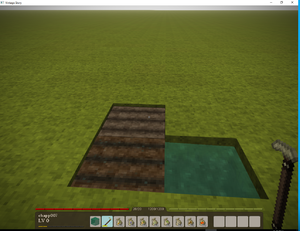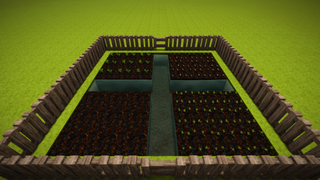農業
農業は、料理で使う作物を育てることができるゲームメカニクスです
必要な素材
農業を始めるためには、良い土と作物を植えるための種が必要です。土を農地に変えるために、専用の道具であるクワが必要です。
種を見つける
野生の作物はワールド生成時に作られ、世界中の様々な気候の地域に存在しています。作物を植えるための種を集めるには、これらの作物を壊すことが不可欠です。成熟していない作物は、壊しても必ず種をドロップするとは限りません。野生の作物はチャンクがロードされていなくても成長し、その成長は気温の影響を受けません。しかし完全に成長した後も、次の成長タイミングまでに収穫しなければ、成長段階1に戻ってしまいます。長旅に出ていて同じ道を通らないと予想される場合は、成長段階にかかわらず全ての作物を収穫することをお勧めします。
種は、廃墟にあるルート品の容器(種と農業用)にも入っていて、この方法でしか手に入らない作物もあります。
| 種の種類 | 産出物 | 場所 |
|---|---|---|
| ニンジン | 温帯 | |
| 亜麻 | 温帯 | |
| タマネギ | 温帯 | |
| スペルト小麦 | 温帯 | |
| カブ | 温帯 | |
| パースニップ | 温帯 | |
| 米 | 温帯 | |
| ライ麦 | 温帯 | |
| 大豆 | 暖帯 | |
| カボチャ | 遺跡のみ | |
| キャベツ | 遺跡のみ |
土と農地
自然に生成される土
自然に存在する土は、肥沃度の異なる4種類、やせた土(5%)、少し肥沃な土(25%)、肥沃な土(50%)、「テラ・プレタ」と呼ばれるとても肥沃な土(80%)があります。土ブロックを集めて別の場所に置いても肥沃度は保たれるため、栄養素の豊富な土を探して持ち帰るのが良い農業戦略となります。
プレイヤーが作る土
堆肥はプレイヤーが作成できる、栄養素65%の土です。この土は、テラ・プレタが見つからない場合の代わりの選択肢になります。堆肥ブロックは64個の腐敗物を樽の中に20日間密閉して作ります。
農地作り
土ブロックをクワ+右クリックで、乾いた農地を作ることができます。農地が水源ブロックから3ブロック以内にある場合、乾いた農地から湿った農地へと変化します。湿った農地を作るには、毎日じょうろで水を撒くか、雨の多い地域では雨に頼るなどの方法もあります。水分量が50%以上になると、成長速度にボーナスが発生します。具体的には、水分が100%の場合、作物が次のステージに成長するまでの総時間が、ゲーム内時間で最大2時間短縮されます。
近くの水は、斜め方向も含む3ブロック以内の水平方向に隣接する農地に水分を供給します。近くの水による水分ボーナスは、農地が水から1ブロック離れるごとに25%ずつ減少します。そのため水ブロックに隣接する農地は75%、2ブロック離れた農地は50%、3ブロック離れた農地は25%の水分ボーナスを得ることができます。農地は垂直方向の水から水分を吸収しません(例えば湖の水面の真上に作られた農地は、下の水から水分を得られません)。
Farmland blocks cannot be picked up and replaced once converted. Breaking farmland destroys the block.
Soil Nutrients
All soil, dirt, dry or moist farmland, has 3 nutrient levels, N, P, and K. Each crop consumes one of these nutrients. Some crops require higher values of nutrients than others, as shown in the table below. Crop growth rates also differ. Each crop has different total growth speed, which is shown by the number of growth days.
When crops advance from one growth stage to the next, they consume nutrients from the farmland on which they are planted. The required nutrient, K, P, or N, is the nutrient that will be consumed, reducing the concentration of that nutrient in the farmland. The amount of the nutrient required per growth stage is determined by dividing the Nutrient Consumption by the number of growth stages.
Nutrient replenishment
Nutrients in farmland slowly replenish over time and return to the maximum level per soil type, for instance medium fertility will only regain nutrients to original levels. The rate of nutrient replenishment is slower if a crop is growing on it and faster when left fallow - meaning no crop growing. The nutrition type used by the currently growing crop will regenerate even slower then the two not actively used, and effectively wont replenish at all, as the currently growing crop reduces it with every growth tick. If the crop on the farmland is ripe, none of the nutrients will replenish.
Nutrition replenishment ticks every 3 to 4 ingame hours.
Crop rotation
Crop rotation is the practice of growing a series of different types of crops in the same area over time and has been used since ancient times to maximize crop production. Nitrogen (N), phosphate (P) and potassium (K) dependent crops can be rotated on the same growing area. For example, after harvesting a nitrogen dependent crop such as turnips, the soil will have a lower level of nitrogen but high levels of the two other nutrients. Therefore a phosphate or potassium dependent crop can be planted in the same soil.
A common crop rotation strategy is to divide the fertile area into four sections, one each for N, P or K dependent crops and one left fallow (without any crops growing). In the screenshot on the right, turnips (N-dependent) are planted in the top left, onions (P-dependent) in the top right, carrots (K-dependent) in the bottom right and the bottom left area is left without any crops. After harvest the planting will be rotated clockwise so that turnips will now be planted in the top right, onions in the bottom right, carrots in the bottom left and the top left will not have any crops. Rotate clockwise again after each harvest.
Note that the rotation will depend on the slowest crop to mature which in this case are the carrots (4 in-game days). Because nutrients replenish best in fallow soil, one area is kept unplanted during each rotation. This strategy is particularly useful if the player does not have access to fertilizer yet. You can make variations on this strategy to suit your crop mix.
Fertilizer
Fertilizer such as saltpeter, potash and bonemeal can be applied to the soil to replenish nutriments depleted by the growth of crops without waiting for the slow natural replenishment in fallow soil (no crops planted) or the need for crop rotation.
For example, the important crop flax removes potassium from the soil as it grows. Adding potash or saltpeter to the depleted soil after harvest will replenish potassium levels and allow replanting of flax on the same soil without waiting for natural replenishment and without the need for crop rotation. The type and amount of nutrient required for each crop is shown in the table of available crops in the next section. Having sufficient nutrients for each crop allows for the optimal growth rate if temperature and light requirements are also met.
Using fertilizer is the only time a soil type can exceed the maximum nutrient level of the soil type.
Note that saltpeter can't be detected by a prospecting pick (propick) and must be found while exploring caves.
| Fertilizer | Nitrogen (N) % | Phosphorus (P) % | Potassium (K) % | Obtained by |
|---|---|---|---|---|
| 0 | 0 | 60 | crushing or grinding sylvite | |
| 13 | 0 | 44 | mined from caves | |
| 3 | 30 | 0 | grinding bones |
Crops
To harvest, left click on the crop with an empty hand or harvesting tool, knife or scythe. Fully mature crops will return seeds, food, and in the case of flax, fiber. All fully mature crops have about a 5% chance to drop an extra seed when harvested. Each crop is characterized by a set of Crop Properties. Crop properties consist of the following individual properties:
- Growth Stages - The number of growth stages for a crop.
- Total Growth Days - The number of in game days it takes for a crop to be fully grown (harvestable).
- Required Nutrient - The type of nutrient (N, P, K) consumed from the farmland when a crop grows to the next stage.
- Nutrient Consumption - The total amount of the required nutrient that will be consumed over the lifetime of a crop.
- Cold/ Heat Resistant Until - Temperature range the crop can endure before it takes damage and then will yield less harvest on breaking. Generally all crops are able to keep growing only above 0°C. They might be able to endure lower temperatures without damage, but will not be able to grow under such circumstances. The only way to regulate temperature for crop growth at the moment is through the use of a greenhouse structure, which will raise the temperature. Keep in mind that getting to cold or too hot can halve the harvest of a crop, but the seeds will always be dropped.
Table of Available Crops
| Crop | Growth Stages | Total Growth | Required Nutrient | Nutrient Consumption | Cold Resistant Until | Heat Resistant Until |
|---|---|---|---|---|---|---|
| 7 | 4 days | K (Potassium) | 40 | -10°C | 32°C | |
| 9 | 4.2 days | K (Potassium) | 50 | -5°C | 40°C | |
| 7 | 3.6 days | P (Phosphorus) | 35 | -1°C | 40°C | |
| 9 | 4.4 days | N (Nitrogen) | 40 | -5°C | 40°C | |
| 5 | 3 days | N (Nitrogen) | 30 | -5°C | 27°C | |
| 8 | 6 days | P (Phosphorus) | 20 | -10°C | 32°C | |
| 10 | 4.2 days | K (Potassium) | 50 | 8°C | 40°C | |
| 9 | 5 days | N (Nitrogen) | 40 | -5°C | 40°C | |
| 11 | 5.4 days | K (Potassium) | 35 | -5°C | 40°C | |
| 8 | 3.5 days | P (Phosphorus) | 30 | -5°C | 40°C | |
| 12 | 6.5 days | N (Nitrogen) | 40 | -5°C | 35°C |
Pumpkins are cultivated differently than all other crops. Please see the pumpkin page for detailed instructions about establishing a pumpkin patch.
Animal attacks
When building a farm, one should keep in mind that rabbits will go after planted crops and eat them. Seeds may drop, depending of plant maturity, and left ignored, but will despawn soon.
Rabbits spawn on grass blocks, so to rabbit-proof your farms, it is recommended to either use a wall, fence or a 2 blocks deep dry moat around the farm blocks, leaving no grass blocks in the enclosed area. The latter offers the added bonus of catching hungry rabbits when they try to reach the players crops.
There are a few crops that will not be eaten by rabbits, namely rice, onions and pumpkins. Those could be planted without protection, however rice and onions should be planted in crop rotation with other plants, which would again need rabbit protection.
Wild crops will be ignored by rabbits.
Underground Farming
Starting with version 1.14, underground farming will no longer be an easily achievable solution. There is now a soft limit for plant growth in relation to depth below sea level: Each level below sea level requires one extra light level for the crop to grow, and below light level 19, each farther level incurs a 10% growth penality, which means growth will stop entirely at light level 9.
Given that the suns light level is 22, this means that with light shafts alone, which would be a direct connection between the sky and the farmland in form of a hole in the ground, farms can be placed at a maximum 3 levels below sea level without incurring growth penalties, and a maximum 12 levels below sea level before growth stops completely. With a fully set chandelier, which would reach light level 24, a slightly lower depth might be reached. However, light levels do not accumulate, meaning combining a light shaft with light level 22 and a lantern with light level 18 will still result in a maximum light level of 22.
"Underground" farms in a mountain range above sea level would however still be possible, as long as the required light level for growth is achieved with sun or artificial light.
In a default height world, sea level is at 110.
Food and Cooking
| Seed Type | Category | Satiety | Satiety/Growth time (days) | ||||
|---|---|---|---|---|---|---|---|
| Raw | Meals | Bread | Raw | Meals | Bread | ||
| Vegetable | 100 | 150 | N/A | 25.00 | 37.50 | N/A | |
| Grain | 30 | 120 | 160 | 7.14 | 28.57 | 38.10 | |
| Vegetable | 100 | 150 | N/A | 27.78 | 41.67 | N/A | |
| Grain | 60 | 240 | 300 | 13.64 | 54.55 | 68.18 | |
| Vegetable | 100 | 150 | N/A | 33.33 | 50.00 | N/A | |
| Vegetable | 100 | 150 | N/A | 16.67 | 25.00 | N/A | |
| Grain | 60 | 280 | 330 | 14.29 | 66.67 | 78.57 | |
| Grain | 60 | 240 | 300 | 12.00 | 48.00 | 60.00 | |
| Protein | 150 | 240 | N/A | 27.78 | 44.44 | N/A | |
| Vegetable | 480 | 720 | N/A | 137.14 | 205.71 | N/A | |
| Vegetable | 300 | 450 | N/A | 46.15 | 69.23 | N/A | |
Video Tutorials
| Detailed explanation including changes since version 1.13 | Detailled explanation of pumpkin plants |
|---|---|
| {{{title}}} | |
|---|---|

